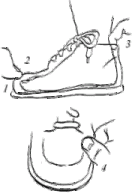Shoe shopping is fun! Many buy shoes according to the color, the outfit they would match, the style and the in-trend ones. How about a shoe that fits right, the one that matches your bone structure and supports your foot well. The one that helps you walk better and run faster.
I have worked in an orthotic and foot specialty clinic in United States where I learnt a lot about foot types, how they differ and what shoes work best for a certain type. Hence, with an attempt to create awareness, I write this post down with a general outline to help select the right shoe for you and your kids.
To begin with, we will talk about the three types of arch heights.
SUPINATION/HIGH ARCH FEET
NEUTRAL/NORMAL ARCH FEET
OVERPRONATION/ FLAT FEET/LOW ARCH FEET
For those who have my Visiting cards, the scale is at the back side.
Another way of checking your Arch type is by wetting your foot and placing it on a paper. The imprint should help you decide which type your feet belong to

A normal foot will have an appropriate medial arch height (inside of your foot) of 3–5 cms with the ankles straight in line with the foot.you should be able to stick in at least 2 fingers on the inside of the feet
Such a foot suits well with any kind of general sports shoes with good structure and moderate amount of padding. One thing that is important for all kind of feet is the size of the shoe.
 It is necessary to have a shoe that allows at least 2 finger space from your big toe inside your toe box.
It is necessary to have a shoe that allows at least 2 finger space from your big toe inside your toe box.- Also the shoe should be as wide as the widest part of your foot which usually is the part right before your toes start.
- If your one foot feels tighter in a shoe. Buy the shoes that fits the tighter foot. Buying shoes of a smaller size can lead to nerve compression and cause deformities in the long run.
- Buy shoes in the evening when your feet are at their biggest size.
This was for all those with Normal Arches and general precautions for all feet types.
Low medial arch/flat feet/ Pronated foot :Crudely Speaking Less than 2 finger space from the floor on the inside arch of feet. Or less than 3 cms on the scale on the backside of my visiting card.
 People with Low Medial Arches need shoes with good support medially and laterally which are called Motion Control Shoes with a stiff middle portion.
People with Low Medial Arches need shoes with good support medially and laterally which are called Motion Control Shoes with a stiff middle portion.- Sometimes depending on the arch height, insole might be required.
- Most of the times, esp in youngsters it is possible to correct the height of the arch with proper feet strengthening exercises and physiotherapy.
- I have corrected arches of older adults and youngsters in less than 15 sessions.
- Correction has shown to decrease the chances of debilitating deformities and injury to the knee and hip in the future.
High Medial Arches/ Supinated Foot: more than 2 finger space between the floor and the inside, often have a stiff medial portion of the foot.
- Our arches have certain amount of flexibility and springiness to be able to absorb shock and prevent injuries.
- A stiff foot is unable to absorb shock. For such a foot it is necessary to have well padded shoes.
- Physiotherapy to mobilize the mid portion of arch also works well to increase flexibility when in pain or during injury.
- The ones available in Indian Market would be the air-sole ones or the shoes with a thick sole.
This is quite a general guide to selecting shoes based on your feet Medial arch type. There are many other variables that are necessary to take a look at, if you have pain or any other type of previous injury. In that case go to a person with appropriate knowledge- a Physiotherapist who specializes in Bio-mechanical analysis or a Orthotist.
But, for the general population this should suffice. Take a lot of care while you select your sport shoes, because our feet are the one, that’s carrying our body around. Happy Feet to you !!





Hi! I love your posts. I really learn a lot about the body’s biomechanics that’s really helpful to me.
What are your views on the recent trend in the west of barefooting and running barefeet and using minimalist shoes in general?
LikeLike
Minimalist shoes and Barefeet running is ok for someone with good running biomechanics . But overall if a person is planning to run on paved paths its better to have some form of cushion between. But again this wouldnt apply to all. Depends a lot on your running biomechanics.
LikeLike